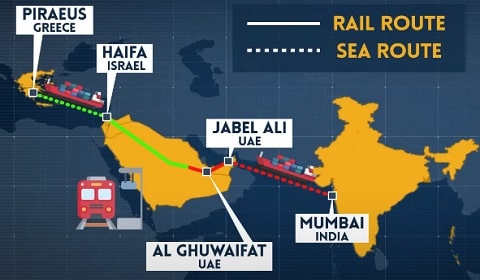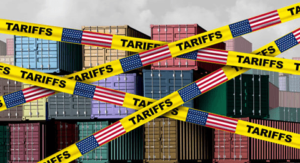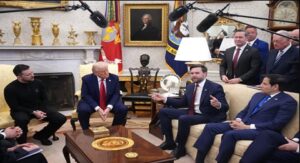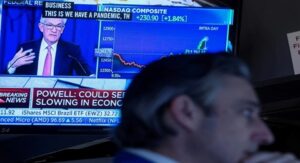
India-Middle East-Europe Economic Corridor
In a significant development at the G20 Summit in New Delhi in September 2023, the India-Middle East-Europe Economic Corridor (IMEC) emerged as a strategic collaboration among seven countries and the European Union.
Spearheaded by the United States, this initiative aims to foster a common geo-economic framework, integrating partners in the Middle East and South Asia. The participating nations, including the EU, France, Germany, India, Italy, Saudi Arabia, the UAE, and the US, signed a memorandum of understanding, outlining plans to establish two corridors connecting Europe to the Gulf and the Gulf to India.
Comprising rail links, electrical and data cables, and pipelines for hydrogen export, the IMEC demonstrates a commitment to ambitious international infrastructure projects, challenging China’s Belt and Road Initiative. Additionally, the corridors will extend connectivity to Israel and Jordan, expanding the economic footprint of this collaborative effort.
Table of Contents
India-Middle East-Europe Economic Corridor
The India-Middle East-Europe Economic Corridor (IMEC), an alternative of One Belt, One Road’ Initiative by China, a key component of the Partnership for Global Infrastructure and Investment (PGII) launched in June 2022, is a transformative 4800 km project. Comprising a railroad, ship-to-rail networks, and diverse transport routes, IMEC is divided into the East Corridor linking the Arabian Gulf to India and the Northern Corridor connecting the Gulf to Europe.
Prominent ports like Fujairah, Jebel Ali, and Abu Dhabi (UAE), Haifa (Israel), Mundra, and Kandla (India), along with Greek (Piraeus), French (Marseille), and Italian (Messina) ports will be interconnected. With a focus on contemporary challenges and policies, the project prioritizes enhancing transport efficiency, curbing greenhouse gas emissions, and fostering employment opportunities. IMEC is poised to reshape economic dynamics across low and middle-income countries.
However, as we delve deeper into the intricacies of this corridor, it becomes evident that its future is marked by uncertainties. This article aims to explore the key factors contributing to the uncertain future of the India-Middle East-Europe Economic Corridor.
1. Hamas–Israel Conflict Derails Progress in Saudi–Israeli Relations and Middle East Partnerships
The promising momentum in Saudi–Israeli normalization talks has been abruptly halted by the eruption of the Hamas–Israel war known as Gaza war on October 7. This conflict has relegated the diplomatic agenda, making it significantly more challenging to establish new economic and political ties between Israel and the Middle East.
Political turmoil between Israel and Jordan have intensified, further complicating regional dynamics. Despite the G20 announcement envisioning the India-Middle East-Europe Economic Corridor (IMEC) ‘action plan,’ participant countries failed to convene a meeting within the stipulated 60 days.
Additionally, the I2U2 minilateral meeting involving India, Israel, the UAE, and the US, scheduled for October, was postponed due to the conflict, signaling potential hurdles in broader regional cooperation.
2. IMEC’s Connectivity Mirage: Unveiling Troubled Projects and Funding Uncertainties
Beneath the surface of the International Middle East Corridor (IMEC) lies a web of repackaged but troubled connectivity initiatives. Notably, the Tracks for Regional Peace, announced in 2017, intended to link Israel, Jordan, and Saudi Arabia through a rail network, remains stalled, leaving questions about its financial backing unanswered.
Another initiative, the Gulf Cooperation Council (GCC) Railway, approved in 2009 with a hefty US$250 billion budget for a regional rail network, faces significant delays, originally expected to be completed by 2018. Additionally, the India-Middle East-Europe Economic Corridor, a burgeoning economic pathway, introduces a new dimension to regional connectivity.
However, the lack of progress on existing projects raises concerns about the overall viability of IMEC, as participant countries have yet to disclose how these ambitious projects will be financed, casting a shadow over the envisioned regional connectivity.
3. UAE-Saudi Railway Link Set for 2024, Yet Challenges Loom
The United Arab Emirates (UAE) is on track to complete its railway network connecting to Saudi Arabia by 2024, bolstering regional transportation infrastructure. Despite this progress, challenges persist in establishing a functional rail connection between Saudi Arabia and Jordan.
Economic and political factors, such as fluctuations in oil prices affecting GCC states’ fiscal capacity, or potential conflicts between Saudi Arabia, the UAE, and Jordan, could impede further advancements.
The international rail link between the UAE, Saudi Arabia, and the India-Middle East-Europe Economic Corridor holds promise for increased connectivity and trade, but uncertainties in the geopolitical landscape may pose hurdles to timely completion and operationalization.
4. Challenges in Infrastructure Projects Raise Doubts about its Role in IMEC
New Delhi faces skepticism over its ability to effectively contribute to the International Maritime Connectivity (IMEC) initiative due to a history of incomplete regional projects, particularly in Africa, Japan, and Sri Lanka.
The absence of a defined strategy for offering viable connectivity and infrastructure alternatives, coupled with uncertainties in integration with South Asian neighbors, raises doubts about India’s capacity to engage meaningfully in connectivity frameworks.
With six South Asian nations already part of the Belt and Road Initiative (BRI), questions linger about New Delhi’s competence in delivering successful projects in the Middle East and Europe, including the India-Middle East-Europe Economic Corridor. India’s track record prompts concern about its role in global connectivity endeavors.
5. IMEC’s Geographical Omissions Raise Questions on Transit Corridor Inclusivity
The International Maritime Exercise Corridor (IMEC) has drawn scrutiny for its exclusion of seemingly strategic nations like Iraq, Oman, and Turkiye. Despite their geographical proximity and potential transit importance, these countries are absent from IMEC’s roster.
Notably, the exclusion of Oman, a member of the International North–South Transit Corridor, raises questions about connectivity. Oman’s capital, Muscat, could have served as a crucial transit point connecting India to Saudi Arabia and the UAE. Additionally, the India-Middle East-Europe Economic Corridor, with its potential to enhance economic ties and connectivity across the region, further underscores the need to reevaluate IMEC’s criteria for inclusion and the potential impact on regional connectivity.
India’s participation in both corridors, linking to Russia through Iran and Central Asian republics via the Economic Corridor, highlights the complex dynamics at play and the importance of a comprehensive approach to maritime and economic cooperation in the region.
6. IMEC: A Balancing Act in the Geopolitical Chessboard
In the complex landscape of global geopolitics, the International Maritime Economic Corridor (IMEC) and the India-Middle East-Europe Economic Corridor emerge as strategic moves, transcending their primary roles in economic and transport connectivity. For India, joining IMEC and participating in the India-Middle East-Europe Economic Corridor serve as diplomatic triumphs, projecting influence and countering the China-Pakistan Economic Corridor.
The corridor’s nomenclature strategically implies an Indian origin, fostering a narrative of connectivity from India to Europe. Meanwhile, Arab states strategically position themselves amid the evolving multipolar world, navigating geo-economic competitions.
In contrast, the United States, with its Partnership on Global Infrastructure Investment, treads a delicate path, delivering alternatives to the Belt and Road Initiative but facing reputational risks due to the absence of clear plans to overcome geopolitical and financial challenges.
Bottom Line
The India-Middle East-Europe Economic Corridor holds immense potential for transforming regional trade dynamics and fostering economic growth. However, the journey towards its realization is fraught with uncertainties arising from geopolitical challenges, infrastructure bottlenecks, regulatory diversity, economic disparities, energy dependency, and environmental concerns.
Navigating these challenges requires collaborative efforts, diplomatic finesse, and strategic planning. As stakeholders continue to work towards the development of this economic corridor, it is crucial to address these uncertainties proactively to ensure a more stable and sustainable future for the initiative.





